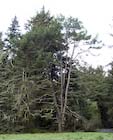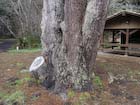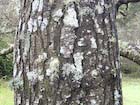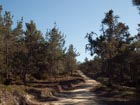Conservation Status

Pinus muricata
D. Don 1836
Common names
Bishop, obispo, pricklecone, dwarf marine, umbrella, bull, pitch, or Santa Cruz Island pine. Older texts call it "obispo" because it was described from near San Luis Obispo; English speakers corrupted that to "bishop," the English translation of "obispo."
Taxonomic notes
Along with Pinus attenuata and P. radiata, this is one of the "closed cone" pines, Pinus sect. Attenuatae. All three species are serotinous pines of the California-Baja California coast, although some have suggested that P. greggii of central Mexico warrants inclusion in this section as well.
Synonymy (Millar 1986, Kral 1993):
- Pinus edgariana Hartweg 1848;
- P. muricata var. anthonyi Lemmon 1892;
- P. remorata H. Mason 1930;
- P. muricata f. remorata (Mason) Hoover 1966
- P. muricata var. borealis Axelrod nom. inval. (holotype not cited);
- P. muricata var. stantonii Axelrod nom. inval. (holotype not cited);
- P. muricata var. remorata (H. Mason) Silba;
Trees with small symmetrical cones, found mainly toward the southern end of the species' range, are sometimes treated as P. remorata. Hoover (1966) thought this character to be inconsequential; he treated it as a forma, the lowest rank of botanical recognition. The earliest name at varietal rank for trees with small symmetrical cones is Lemmon's var. anthonyi, a name overlooked by many subsequent authors.
Trees in the north of the range differ in having glaucous foliage and a taller, narrower crown habit; see Remarks, below.
Description
Trees to 24 m and 90 cm dbh, straight to contorted, crown rounded, flattened, or irregular. Bark dark gray, deeply furrowed into long ridges, scaly-plated. Branches spreading-ascending, often contorted. Shoots slender to stout, orange-brown, aging darker brown, rough. Needles two per fascicle, spreading to upcurved, persisting 2-3 years, 8-15 cm × (1.2-)1.5(-2) mm, slightly twisted, dark yellow-green (glaucous blue-green in northern populations), all surfaces with stomatal lines, margins strongly serrulate, apex abruptly conic-acute; sheath to 1.5 cm, base persistent. Buds ovoid-cylindric, dark brown, 1-2.5 cm, resinous. Pollen cones ellipsoid, to 5 mm long, orange. Seed cones maturing in 2 years, serotinous, persisting for up to 70 years (or more; longer than any other pine; often old cones are enveloped by the growing branch or trunk), mostly in whorls, mostly asymmetric, lanceoloid-ovoid before opening, curved-ovoid when open, 4-9 cm long, rich glossy chestnut-brown, sessile or on stalks to 2-4 mm long, mostly downcurved. Cone scales with a deep red-brown distal border (the sealing band, yellow-brown on fresh cones but darkening with age) distally on adaxial surface; apophyses usually much thickened, the abaxial ones progressively more angulately dome-shaped toward base of cone; umbo central, a stout-based, curved claw. Seeds obliquely ellipsoid; body 6-7 mm, dark brown to near black; wing 15-20 mm. 2n=24 (Kral 1993, M.P. Frankis e-mail 1999.03). See García Esteban et al. (2004) for a detailed characterization of the wood anatomy.
Distribution and Ecology
USA: California; Mexico: Baja California Norte; at 0-300 m elevation. Occurs in scattered locales along the coast and offshore on Santa Cruz and Santa Rosa Islands of California, and Islas Cedros and Guadalupe in Baja. Habitats include dry ridges to coastal, windshorn forests, often in or around bogs or in other nutrient-poor soils. There is also a report of the species occurring in the Takenitch Lake area in southwestern Oregon. The species is rare enough to be of conservation concern (Kral 1993). Hardy to Zone 8 (cold hardiness limit between -12.1°C and -6.7°C) (Bannister and Neuner 2001). See also Thompson et al. (1999).
Distribution data from USGS (1999).
This species is listed as endangered in Mexico under NOM-ECOL-059-94.
Remarkable Specimens
Diameter 139 cm, height 34 m, crown spread 12 m. Locality: Mendocino County, California (American Forests 1996).
The tallest I have seen documented was a tree near Trinidad, California that was 122 cm dbh and 51.8 tall (Metcalf 1921). This tree occurred on a site that was being logged at the time.
The oldest known living specimen, 161 years, was documented in a tree-ring chronology covering the period 1846-2008 (fully crossdated), collected at a site named "Ecological Staircase Terrace 2" on the Mendocino coast of California by Steven Voelker (doi.org/10.25921/z79b-8t53). Only one chronology has been developed for this species, and older trees likely exist.
Ethnobotany
The wood is very fragrant, and its heartwood very rot-resistant. Tony Broad (email 2024.08.02) reports that "we have distilled oil from the sawdust: the yield is high (up to 40ml per kg) and it makes a lovely perfume."
Observations
Can be seen along the northern end of Inverness Ridge at Point Reyes National Seashore, and at Patrick Point State Park, both in California.
Remarks
The species was discovered in 1835 by a young Irish botanist named Thomas Coulter, memorialized by another species he collected that year, Pinus coulteri. He collected it near Mission San Luis Obispo, thus the name "Bishop" pine (Little 1980). It was published by D. Don the following year in the Transactions of the Linnaean Society with the epithet muricata. The closest Latin word is muricatim, which means "shaped like a purple snail"; this is a reference to the mollusc family Muricidae, some members of which have very spiky, conical shells; thus the epithet compares the cones of P. muricata to the shells of the Muricidae (Tony Broad, email 2024.08.02).
"P. muricata is quite variable in terms of morphological, genetic, geographical, physiological, ecological and chemical characteristics. Research by Millar (1983, 1986) and Lloyd (1975) has attested to a steep cline within the species. Pinus muricata is divided into four varieties [not all validly published; see taxonomic notes, above]: muricata, borealis, remorata, and cedrosensis. The differences between the varieties are based on tree size, foliage, bark, and cones. Millar (1983) states that in northern California, a continuous population extends 180 kilometers from Ft. Ross to Ft. Bragg with several morphological and biochemical characteristics changing abruptly at Sea Ranch (27 km north of Ft. Ross). The northern population is called the blue strain (due to the blue colored cast to the foliage) and the southern population is called the green strain (due to deep green foliage). The differences in the strains are related to stomatal anatomy, waxiness of needles, monoterpene composition, allozymes, and the flowering phenology. It is thought that the evolution of these different strains is due to population biogeographic movement and adaptation to unique soils. Millar (1986) felt that sufficient allozymic variation exists to encourage isozyme analysis for further genetic studies with Bishop pine" (Trees of California website, http://biology.fullerton.edu/courses/biol_445/web/, now defunct).
The northern 'blue' trees, probably distinct at subspecific rank or even a separate species, are without a scientific name; Axelrod's [invalid] var. borealis was described from Salt Point, Sonoma Co., about 20 km south of the southernmost 'blue' trees at Sea Ranch, on the Coast Hwy at the Annapolis road junction. They have proved impossible to hybridise with the typical 'green' trees in controlled experiments. (Millar 1983, 1986; Millar and Critchfield 1988; Millar et al. 1988).
The northern 'blue' trees have shown promise as a potential timber tree in Britain and New Zealand, with growth rates of up to 2m/year when young even on very poor sandy soils.
In its native range, this species is a principal host for the dwarf mistletoe Arceuthobium littorum (Hawksworth and Wiens 1996).
Citations
American Forests 1996. The 1996-1997 National Register of Big Trees. Washington, DC: American Forests.
Don, D. 1836. Descriptions of five new species of the genus Pinus discovered by Dr. Coulter in California. Trans. Linn. Soc. London 17:439-444. Available at the Biodiversity Heritage Library, accessed 2022.12.23.
Hoover, R. F. 1966. Miscellaneous new names for California plants. Leafl. West. Bot. 10: 337-338.
Metcalf, Woodbridge. 1921. Notes on the Bishop pine (Pinus muricata). Journal of Forestry 19:886-902. Available: Biodiversity Heritage Library, accessed 2023.11.12.
Millar, C. I. 1983. A steep cline in Pinus muricata. Evolution 37: 311-319.
Millar, C. I. 1986. The Californian closed-cone pines; a taxonomic history and review. Taxon 35: 657-670.
Millar, C. I. and W. B. Critchfield. 1988. Crossability and relationships of Bishop Pine. Madroño 35: 39-53. Available: Biodiversity Heritage Library, accessed 2021.12.19.
Millar, C. I., S. H. Strauss, M. T. Conkle and R. D. Westfall. 1988. Allozyme differentiation and biosystematics of the Californian closed-cone pines. Systematic Botany 13: 351-370.
This page co-edited with M.P. Frankis, 1999.03.
See also
Elwes and Henry 1906-1913 at the Biodiversity Heritage Library. This series of volumes, privately printed, provides some of the most engaging descriptions of conifers ever published. Although they only treat species cultivated in the U.K. and Ireland, and the taxonomy is a bit dated, still these accounts are thorough, treating such topics as species description, range, varieties, exceptionally old or tall specimens, remarkable trees, and cultivation. Despite being over a century old, they are generally accurate, and are illustrated with some remarkable photographs and lithographs.
Farjon and Styles 1997.
FEIS database.
Millar, C.I. 1985. Inheritance of allozyme variants in Bishop pine (Pinus muricata D. Don). Biochemical Genetics 23(11/12):933-946.
Sargent, J. S. 1897. Pinus muricata. Garden and Forest 10:232. Available at the Biodiversity Heritage Library, accessed 2024.12.24. Early report on the natural history of this species.










